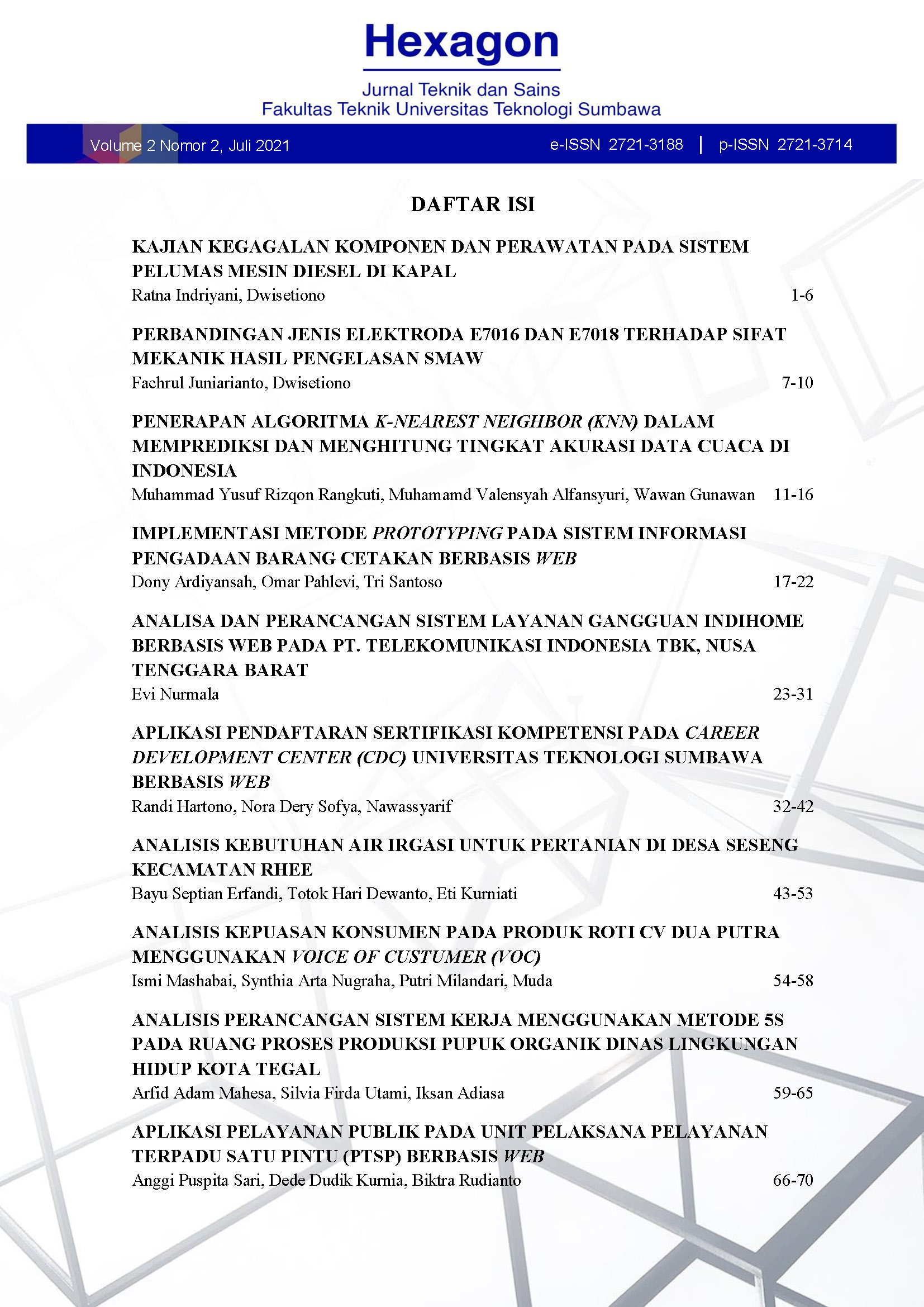PENERAPAN ALGORITMA K-NEAREST NEIGHBOR (KNN) DALAM MEMPREDIKSI DAN MENGHITUNG TINGKAT AKURASI DATA CUACA DI INDONESIA
DOI:
https://doi.org/10.36761/hexagon.v2i2.1082Keywords:
Weather prediction, Level of accuracy, K-Nearest NeighborAbstract
Indonesia is a country that has a very large disaster-prone area, so that it can be dubbed the 1001 disaster country. It was recorded that throughout January 2020 there were 518 earthquakes, while in February 2020 there were an increase of 799 earthquakes. It is not just earthquakes that occur in Indonesia, floods, landslides, extreme rainfall, and very drastic temperature changes that occur in Indonesia every year. Hydroclimatologically, Indonesia is also affected by the phenomenon of ENSO (EL_Nino Southern Oscillation) and La Nina, resulting in floods, landslides, drought, and low temperatures (cold). This research will implement the K-NN Algorithm in Predicting and Calculating the Level of Accuracy of Weather Data in Indonesia. The data used is 3623 data which is then divided into training data and testing data with a ratio of 80: 20, 80% for training data or as much as 2898 data from 3623 data and for testing data as much as 20% or as much as 725 data from 3623 data. produce a prediction with a data accuracy rate of 0.8993 or about 89%. With a data accuracy rate of 89%, it is hoped that it can help predict temperature and weather in Indonesia, so that it can help breeders and farmers to reduce the risk of crop failure and disadvantage.
References
A. Riki, (2018). “4 Alasan Kenapa di Indonesia Sering Terjadi Gempa Bumi,” www.idntimes.com.
A. perdana Putra, (2020). “Kenapa Sering Terjadi Bencana di Indonesia?,” www.pahamify.com.
Statista, “Global earthquake death toll from 2000 to 2015 Published by Statista Research Department, Sep 30, 2016 The statistic shows the global death toll due to earthquakes from 2000 to 2015. Around 9,624 people died worldwide in 2015 as a result of earthquakes. E,” www.statista.com, 2016. .
H. Hadi and U. (2020). Hamzanwadi, “INTERNALISASI KARAKTER PEDULI LINGKUNGAN DAN TANGGAP BENCANA”.
Y. Nurhanisah, (2019). “Mengenal Perubahan Iklim, Faktor, dan Dampaknya,” www.indonesiabaik.id.
I. M. Sudarma and A. R. As-syakur, “Dampak Perubahan Iklim Terhadap Sektor Pertanian Di Provinsi Bali,” SOCA J. Sos. Ekon. Pertan., no. February, p. 87, 2018, doi: 10.24843/soca.2018.v12.i01.p07.
L. A. Azanella, (2020). “Suhu Dingin di Indonesia: Penyebab, Wilayah yang Mengalami, dan Tips Kesehatan,” www.kompas.com.
R. Putratama, (2020). “Awal Musim Hujan 2020/2021 Mulai Akhir Oktober,” www.bmkg.go.id.
J. S. Arie, (2019). “Implementasi Algoritma KNN Dalam Memprediksi Curah Hujan dan Temperatur Untuk Tanaman Padi,” vol. 8, no. 1, pp. 11–20
BMKG, (2017). “Prakiraan Awal Musim Kemarau 2017,” pp. 1–129.
N. Reflan, A. Aflahah, Kusrini, and Juwari,. “Implementasi Metode K-Nearest Neighbor (Knn) Untuk Memprediksi Varietas Padi Yang Cocok Untuk Lahan Pertanian,” J. Inf. Politek. Indonusa Surakarta, 2018. vol. 4, pp. 2–8,
A. Rohman, “Model Algoritma K-Nearest Neighbor (K-NN) Untuk Prediksi Kelulusan Mahasiswa,” Neo Tek., vol. 1, no. 1, 2015, doi: 10.37760/neoteknika.v1i1.350.
Published
Issue
Section
Copyright (c) 2021 Hexagon

This work is licensed under a Creative Commons Attribution 4.0 International License.



